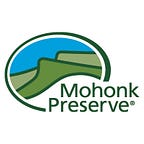Research Report #2 — Forest Vegetation Changes: A Plant Community Transition — per stirpes
For many years scientists and naturalists have been studying and observing the flora and fauna of the Shawangunk Ridge. Foremost among them was Daniel Smiley, for whom Mohonk Preserve’s Daniel Smiley Research Center is named. Dan wrote numerous reports summarizing his observations on various topics. This regularly occurring series will feature some of these reports; some hold tremendous scientific value today and just await an interested researcher to follow up, others showcase a quirky sense of humor or highlight an oddity of nature.
Read the report: Forest Vegetation Changes: A Plant Community Transition — per stirpes. June 1985. Paul C. Huth and Daniel Smiley.
A note from Director of Research Emerita Paul Huth:
Dan’s keen interest in Shawangunk natural history was always influenced by trying to understand ecosystem changes over time and their causes. This included the interaction between natural forces and human influences.
Dan had learned about and documented major forest and land use changes from Mohonk records, local popular articles, published reports and records, photographs, and his interaction with local employees of the Mountain House who lived in places like the Trapps Mountain Hamlet, The Clove, Rock Hill, and in the New Paltz area. Other changes he and previous Smiley Family Members documented first hand, like the sad experience of the onset of blight that decimated native American Chestnut, and numerous forest fires.
For our Research Report, we concentrated our field work in a 40 meter diameter circle with its center, a large mature Hemlock tree immediately adjacent to Laurel Ledge Road. This large 80 foot tall tree was featured in an historic 1900 Smiley Family photograph of the newly completed Laurel Ledge Road on the Mohonk Estate. It’s age was determined to be some 300 years, when cored by Mohonk Trust Research Associate Edward R. Cook in 1974, as part of his Master of Science Degree research at the University of Arizona.
Since this tree lived through all of the major ridge settlement, wood harvesting, fire, and invasive species impacts of the last 285 years or so, we felt it’s annual rates of growth might be revealing. An increment core we took showed 130 years of age in the outer five inches of radius. We wanted to see if subtle changes in growth could be integrated with available items of history as it related to the surrounding forest. This, in our continued interest in vegetational history as it related to major forest changes resulting from local human impacts like the cutting of Hemlocks and bark removal for tanning (pre-1855) and the extensive hoop pole cutting for production of barrel hoops (1855–1864). We also looked at potential impacts of the building of Laurel Ledge Road in 1900 and the loss of American Chestnut from imported blight which arrived at Mohonk in 1912.
Since this report was completed 32 years ago, major forest changes have continued in the area of Laurel Ledge Road. The center piece Hemlock tree lived through the arrival of the invasive Woolly Adelgid in July 1991 near Spring Farm and the insects spread to ultimately kill a large number of hemlocks nearby and elsewhere on Mohonk Preserve lands. Then, on 21 December 2000, after some 350 years of age, the center piece Hemlock broke at the base and fell into the woods. Today, it’s decaying trunk can still be seen along Laurel Ledge Road, the loose bark now supporting bracket fungi.
When ever I pass this way I think of the forest and how it has changed over time from both human and natural causes, and how it is likely to continue to change. If we at Mohonk Preserve are good stewards, this plant community will continue in transition, per stirpes.
Read the report: Forest Vegetation Changes: A Plant Community Transition — per stirpes. June 1985. Paul C. Huth and Daniel Smiley.
